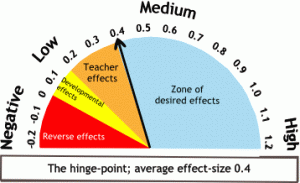This is post number six in a ten part blog series (you may click here to start from the beginning).
This blog series serves to highlight the most significant findings from John Hattie’s 2012 work, Visible Learning for Teachers: Maximizing Impact on Learning and their applications to our classrooms. His work has given educators quantifiable insights that have no parallel in the field of education.
Need an introduction or a crash course on the effect sizes referenced below? An effect size of 0.40 is what Hattie refers to as a hinge-point regarding what is significantly effective or at “a level where the effects of innovation enhance achievement in such a way that we can notice real-world differences” (Hattie, 2009). Anything between a 0.00 and 0.39 is growth, but is not considered significant growth. Anything below a 0.00 is considered detrimental to student growth.
Number 5 – Providing Formative Evaluation of Programs (effect size = 0.90)
Formative evaluation is one of the cornerstones of Hattie’s visible learning premise. The power of immediate feedback to impact student achievement has few equals in regards to effect size. He asserts that it is important for teachers “to pay attention to the formative effects of their teaching, as it is these attributes of seeking formative evaluation of the effects (intended and unintended) of their programs that makes for excellence in teaching” (2009, p. 181).
Hattie found that when teachers use data and evidence-based models the effect size was higher than when teacher judgment was used. Furthermore, when the formative data was graphed the effect size was higher than when it was only recorded.
Application to the Classroom
If you are an educator that is fortunate enough to have a 1:1 instructional environment, or at least easy access to classroom technology, there are a multitude of online formative assessment tools that can redefine your formative evaluation methods and feedback effectiveness.
Hubpages.com lists some of the top tools out there (Socrative, Formative, Kahoot!, Google Forms, and Quizzizz) which provide the opportunity for efficient and focused feedback to inform both the teacher and the student how they are progressing. Most of these tools and many others provide easy to use graphs, charts, and spreadsheets to capture the feedback in the most user-friendly ways. For a more extensive list check out NWEA’s list of 50 digital formative apps and tech tools.
A Random Mention
Number 69 out of 150 – Reducing Anxiety (effect size 0.40)
Research in education on this topic primarily revolves around test anxiety and mathematics anxiety and its consequences include avoidance and inability to achieve. The studies cited in Hattie’s work show that gains in achievement can occur if anxiety is reduced. Specific testing attributes such as the use of “none of the above” as an answer option, distorted pictures on word problems, and the presence of ‘extraneous information’ in word problems were all shown to provoke anxiety.
A Peek at the Bottom 10
Number 145 out of 150 – School Open vs. Traditional (effect size 0.01)
Hattie refers to open programs with open space having its ‘heydey’ in the 1970s and 1980s. He cites that “too often classroom architecture may be open but that is no guarantee that the principles of open teaching are present” (2009, p. 88). Most studies find slight leanings towards open or traditional in regards to classroom achievement, but overall they were equally effective. The open concept did produce positive results in regards to self-concept, creativity, and a positive attitude towards school, but not towards student achievement.
For more from this blog series view the following posts:
#8 – Comprehensive Interventions for Learning Disabled Students
Hattie, J., Visible Learning: A Synthesis of Over 800 Meta-Analyses Relating to Achievement (2009)
Hattie, J. Visible Learning for Teachers: Maximizing Impact on Learning (2012)
http://hubpages.com/education/Formative-Assessment-Tools-for-Teachers
Effect size image retrieved from: http://www.learningandteaching.info/teaching/what_works.htm








February 28, 2020 at 4:50 pm
Hi, Dr Bullis.
I think that the tools listed here in ‘Application to the classroom’ are useful for formative assessment of students; but I don’t see how they would assist with formative evaluation of the program itself.
My reading is that Hattie describes the formative evaluation of programs; not of students.
This leads to a question on we might best introduce evaluation of programs. I’d be interested in your suggestions.
Regards,
Tom
March 2, 2020 at 2:16 pm
Hi Tom,
I could see how Hattie’s labelling could steer people’s thinking towards a comment such as what you shared. Hattie is indeed referring to formative assessment in the classroom. Here is an excerpt from the Glossary of Hattie’s Influences (https://visible-learning.org/glossary/) which highlights this:
According to Hattie (2012) and Black & Wiliam (2001) formative evaluation refers to any activity used as an assessment of learning progress before or during the learning process itself. In contrast with formative assessment, the summative assessment evaluates what students know or have learned at the end of the teaching, after all is done. Watch this video to learn more about the difference between formative and summative assessment methods. In another video you can learn from teachers who describe their experience with formative evaluation.
Example for formative evaluation: Spend the same amount of time or even more on formative assessment as you spend on summative assessment. Give descriptive feedback to students: What is the goal? Where are you in relation to it? What can you do to close the gap?
Hattie cites two meta-studies:
Fuchs & Fuchs (1986): Effects of systematic formative evaluation (Abstract)
Burns & Symington (2002): A Meta-analysis of Prereferral Intervention Teams: Student and Systemic Outcomes (Abstract)